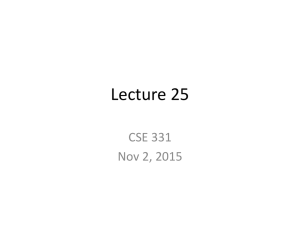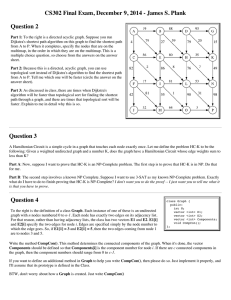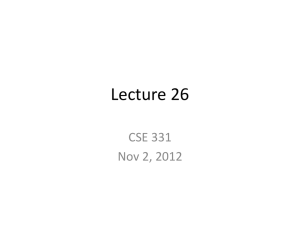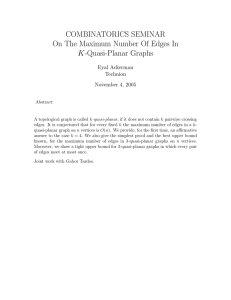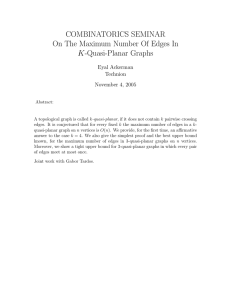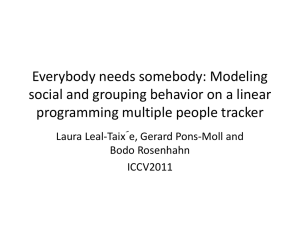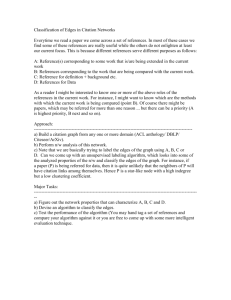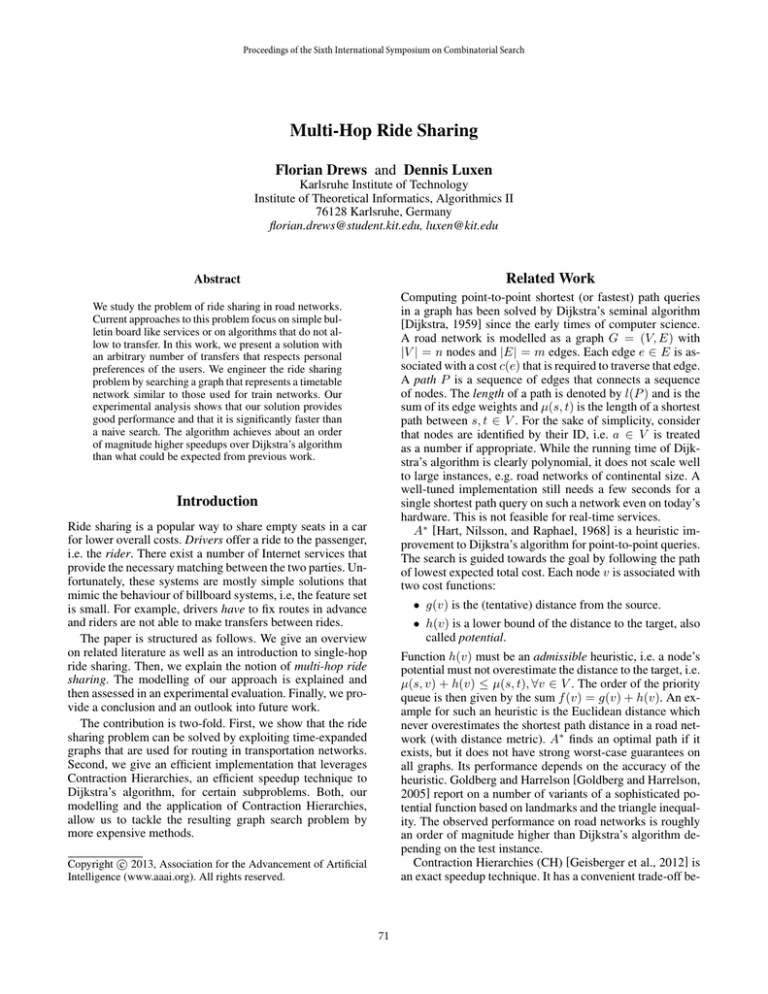
Proceedings of the Sixth International Symposium on Combinatorial Search
Multi-Hop Ride Sharing
Florian Drews and Dennis Luxen
Karlsruhe Institute of Technology
Institute of Theoretical Informatics, Algorithmics II
76128 Karlsruhe, Germany
florian.drews@student.kit.edu, luxen@kit.edu
Related Work
Abstract
Computing point-to-point shortest (or fastest) path queries
in a graph has been solved by Dijkstra’s seminal algorithm
[Dijkstra, 1959] since the early times of computer science.
A road network is modelled as a graph G = (V, E) with
|V | = n nodes and |E| = m edges. Each edge e ∈ E is associated with a cost c(e) that is required to traverse that edge.
A path P is a sequence of edges that connects a sequence
of nodes. The length of a path is denoted by l(P ) and is the
sum of its edge weights and µ(s, t) is the length of a shortest
path between s, t ∈ V . For the sake of simplicity, consider
that nodes are identified by their ID, i.e. a ∈ V is treated
as a number if appropriate. While the running time of Dijkstra’s algorithm is clearly polynomial, it does not scale well
to large instances, e.g. road networks of continental size. A
well-tuned implementation still needs a few seconds for a
single shortest path query on such a network even on today’s
hardware. This is not feasible for real-time services.
A∗ [Hart, Nilsson, and Raphael, 1968] is a heuristic improvement to Dijkstra’s algorithm for point-to-point queries.
The search is guided towards the goal by following the path
of lowest expected total cost. Each node v is associated with
two cost functions:
We study the problem of ride sharing in road networks.
Current approaches to this problem focus on simple bulletin board like services or on algorithms that do not allow to transfer. In this work, we present a solution with
an arbitrary number of transfers that respects personal
preferences of the users. We engineer the ride sharing
problem by searching a graph that represents a timetable
network similar to those used for train networks. Our
experimental analysis shows that our solution provides
good performance and that it is significantly faster than
a naive search. The algorithm achieves about an order
of magnitude higher speedups over Dijkstra’s algorithm
than what could be expected from previous work.
Introduction
Ride sharing is a popular way to share empty seats in a car
for lower overall costs. Drivers offer a ride to the passenger,
i.e. the rider. There exist a number of Internet services that
provide the necessary matching between the two parties. Unfortunately, these systems are mostly simple solutions that
mimic the behaviour of billboard systems, i.e, the feature set
is small. For example, drivers have to fix routes in advance
and riders are not able to make transfers between rides.
The paper is structured as follows. We give an overview
on related literature as well as an introduction to single-hop
ride sharing. Then, we explain the notion of multi-hop ride
sharing. The modelling of our approach is explained and
then assessed in an experimental evaluation. Finally, we provide a conclusion and an outlook into future work.
The contribution is two-fold. First, we show that the ride
sharing problem can be solved by exploiting time-expanded
graphs that are used for routing in transportation networks.
Second, we give an efficient implementation that leverages
Contraction Hierarchies, an efficient speedup technique to
Dijkstra’s algorithm, for certain subproblems. Both, our
modelling and the application of Contraction Hierarchies,
allow us to tackle the resulting graph search problem by
more expensive methods.
• g(v) is the (tentative) distance from the source.
• h(v) is a lower bound of the distance to the target, also
called potential.
Function h(v) must be an admissible heuristic, i.e. a node’s
potential must not overestimate the distance to the target, i.e.
µ(s, v) + h(v) ≤ µ(s, t), ∀v ∈ V . The order of the priority
queue is then given by the sum f (v) = g(v) + h(v). An example for such an heuristic is the Euclidean distance which
never overestimates the shortest path distance in a road network (with distance metric). A∗ finds an optimal path if it
exists, but it does not have strong worst-case guarantees on
all graphs. Its performance depends on the accuracy of the
heuristic. Goldberg and Harrelson [Goldberg and Harrelson,
2005] report on a number of variants of a sophisticated potential function based on landmarks and the triangle inequality. The observed performance on road networks is roughly
an order of magnitude higher than Dijkstra’s algorithm depending on the test instance.
Contraction Hierarchies (CH) [Geisberger et al., 2012] is
an exact speedup technique. It has a convenient trade-off be-
c 2013, Association for the Advancement of Artificial
Copyright Intelligence (www.aaai.org). All rights reserved.
71
tween preprocessing and query time by exploiting the inherent hierarchy of a road network. CH shortcut all nodes of
the graph in some order. Contracting means that a node is
(temporarily) removed from the network and replaced by as
few shortcut edges as possible to preserve shortest path distances. The resulting data structure of the Contraction Hierarchies preprocessing is the union of the original graph and
the set of shortcut edges. A shortest path computation on this
data structure is essentially a bidirectional version of Dijkstra’s algorithm that considers only edges to more important nodes, i.e. so-called upward edges. Note that this graph
forms a directed acyclic graph (DAG) where edges only lead
to more important nodes, i.e. nodes contracted later. The set
of forward edges in this DAG is denoted by G↑ and the set of
reverse, i.e. backward, edges by G↓ . The length of a shortest path from node u to v in the forward (backward) search
space is denoted by d↑ (u, v) (d↓ (u, v)). The only crucial
difference to bidirectional Dijkstra is the stopping criterion
of the bidirectional search that adds nodes into the priority
queues until the tentative distance of an added node exceeds
the lower bound that may exist for a shortest path. A shortest path goes over a middle node that is settled in both (half)searches and for which CH guarantee correct labelling in
both search directions.
Computing a table of all pairwise shortest path distance
between a set of nodes can be trivially done by running
a quadratic number of queries. While this is already significantly faster with Contraction Hierarchies than with a
naive implementation of Dijkstra’s algorithm, this table can
be computed much more efficiently with the algorithm of
[Knopp et al., 2007]. The main observation is that when
computing a quadratic number of pairwise distances a recurring set of important nodes gets settled in nearly all
searches. The algorithm basically consists of two phases of
half searches which we explain below. Consider a set of
sources S and a set of targets T . Also, consider an initialized, but empty distance table D, i.e. all entries set to ∞. In
the first phase, a simple CH backward search is conducted
for eachnode t ∈ T . During each of these half searches,
the pair t, d↓ (v, t) is noted for each settled node v ∈ G↓ .
Thus, the algorithm notes the distances to the target nodes at
each and every potential middle node that is settled during
the backward search phase. The information that is stored at
each node v is called a bucket bv , which is an unsorted, but
dynamic array in practice.
In the second phase of the distance table computation, the
forward searches are conducted for all nodes s ∈ S. Whenever a node v is settled at distance d↑ (s, v), its
bucket bv
is scanned. Given a bucket element t, d↓ (t, v) , the corresponding entry in the distance table D[s, t] is updated if the
following condition holds:
a non-empty bucket at all. Computing such a distance table
with the above algorithm is a matter of mere seconds since
only O(|S| + |T |) half searches have to be conducted. The
quadratic overhead to initialize and update the distance table entries is close to none in practice. It is easy to see, that
computing a one-to-many (or many-to-one) query is a special case of the general algorithm to compute distance tables.
We will use this algorithm in the description of single-hop
ride sharing as was as our own method of multi-hop ride
sharing from the subsequent section.
A related method is Transit Node Routing by [Bast,
Funke, and Matijevic, 2009] which was recently simplified
by [Arz, Luxen, and Sanders, 2013]. It exploits the observation that (almost) all long distance paths will enter an arterial network at some point. Queries are computed by getting
to the entrance into this sub network quickly and combining
it with information from a preprocessed distance table. Local routes that do not enter the arterial network are computed
by a fallback algorithm. So, the preprocessing must compute
this information. Somewhat similar is the method of Compressed Path Databases [Botea, 2011] that exploits similar
properties in game graphs. Unfortunately, the preprocessing
is super-linear and, thus, is unlikely to scale well in practice
on graphs with millions of nodes and edges.
Single-Hop Ride Sharing
The following method by [Geisberger et al., 2010] computes
offers with the smallest detours with respect to a request. We
give a short recapitulation of the method here.
An offer perfectly fits a request only if origin and destination locations of driver and rider are identical, but requirements are more diverse in reality. For example, drivers
and riders make detours when meeting at a specific location.
Assume that network distances resemble costs. A matching
that considers these kind of detours is said to compute reasonable fits:
Definition 1 An offer o = (s, t) and a request g =
(s0 , t0 ) form a reasonable fit if there exists a path P =
hs, . . . , s0 , . . . , t0 , . . . , ti in G with l(P ) ≤ µ(s, t) + ε ·
µ(s0 , t0 ), with ε > 0.
In this setting, the driver is given an incentive to pick up
the rider at their start location s0 and to drop them off at
their destination t0 . While trivial choices for the tuning parameter, e.g. ε = ∞, make any match reasonable, a match
is economically worthwhile if and only if there is an ε for
which
µ(s, s0 )+µ(s0 , t0 )+µ(s0 , t0 )+µ(t0 , t)−µ(s, t) ≤ ε·µ(s0 , t0 ).
(1)
holds. Again, we are assuming that network weights resemble traveling costs. It is easy to see that reasonable passengers will pay at most 21 · µ(s0 , t0 ). Otherwise, it would be
cheaper for the passenger not to join the ride at all. In other
words, joining reasonable rides allows travelers to have costs
lower than those associated with traveling alone.
Matching can be done in this setting by evaluating distances from a request to offers in the data base. For a
dataset of k offers oi = (si , ti ), i=1..k, and a single request g = (s0 , t0 ), 2k + 1 shortest path distances µ(s0 , t0 ),
D[s, t] > d↑ (s, v) + d↓ (v, t) .
| {z } | {z }
forw. search
bucket entry
Note that this condition is tested for each bucket and every
entry encountered during the second phase of the algorithm.
The search spaces are small. Hence, the size of the buckets will be small, as will be the number of nodes that carry
72
at t is given by τ 0 := τ + µ(s, t). Note that travel times on
the road network are time-independent, whereas ride sharing
on top of this network is modelled with time-dependency.
For now, we say that a driver has only one empty seat to
share but that a rider can make several transfers. We note
that a rider and driver may have to wait for some to actually
join a ride. We denote the waiting time at station si for a
given match m by ωm (si ) and the duration of path P :=
hs0 , s1 , . . . , st i by
µ(si , s0 ) and µ(t0 , ti ) are evaluated. The detour for offer oi
is µ(si , s0 ) + µ(s0 , t0 ) + µ(t0 , ti ) − µ(si , ti ).
The algorithm of [Knopp et al., 2007] is adapted to store
preprocessed (half-)search spaces in buckets. For each si the
forward search space G↑ (si ) is computed in advance and
stored in the forward bucket each potential meeting node u.
Likewise, backward buckets are stored to speed up the computation of all µ(t0 , ti ). The shortest path distance µ(s0 , t0 )
is computed separately. Queries are done by running a backward (forward) search from s0 (t0 ) and checking against the
forward (backward) bucket of each encountered node in the
search space. Queries for a data base of 105 entries run in the
order of 5–50 milliseconds depending on values for ε. Unfortunately, the method is not easily generalizable to making
transfers with efficient computation of minimum detours.
Likewise, the offers are time-independent which makes it
necessary to ignore bucket entries that are in the past or have
too much waiting time to be reasonable. Also, it may be necessary to keep separate databases for each day. We refer the
reader to the publication of [Geisberger et al., 2010].
Interestingly, [Abraham et al., 2012] provide a different
variant of the single-hop ride sharing algorithm based on
hub labeling using a technique called double-hub indexing.
The query duration does not depend on the number of offers,
but on the squared size of the label set of source and target
nodes, which can be asymptotically less work.
d(m) = d(P ) :=
t
X
(ωm (si ) + µ(si , si+1 )) .
i=0
The raw travel time (without any waiting) µ(s1 , st ) :=
P
i µ(si , si+1 ) is the sum of the individual travel times. As
we are dealing with a scenario that accounts for departure
and arrival times, we have to account for the fact that waiting periods must not be infinite. The rider should not have to
wait too long for pick up. And the driver is usually already
taking a detour to pick up the rider as argued previously.
Thus, waiting times should be limited by a factor δ ≥ 0.
It models the maximum percentage of time relative to the
shortest path distance offer (request) that rider (or driver)
are willing to wait in order to share the ride. We define reasonable delays for rider and driver:
Definition 2 (Reasonable Delay) A match m is said to
have reasonable driver’s delay if the waiting does not exceed
a relative threshold, i.e.
Multi-Hop Ride Sharing
We like to give users of a ride sharing system even greater
flexibility. Instead of allowing the riders to join one and only
one driver, we allow them to transfer between drivers, i.e.
ride with one driver for some time and then transfer to another one. The algorithm of Section can be extended to handle more than one hop by checking more distances, but this
leads to a combinatorial explosion for all the pairwise distances that must be checked. But multiple hops may lead to
connections that would have been impossible otherwise.
The paper is structured as follows. First, we present ideas
on how to model multi-hop ride sharing in a merged setting
of routing in a dynamic transport network with timetables on
top of a road network. Furthermore, our model allows driver
and rider specific preferences like maximum wait times and
maximum detour. Second, we apply this model to develop
an abstract representation of reasonable routes and describe
the algorithms that add and remove offers, as well as the
corresponding query algorithm to find best matches. Third
and finally, we conduct an experimental study on the performance and quality of our solution.
δd ≥ d(P ) −
d(P ) − µ(s, t)
d(P )
=
− 1.
µ(s, t)
µ(s, t)
(2)
Let r = (s0 , t0 , τ, δr ) be a request for a set of offers O and
P := hs1 , . . . , sn i a path where the potential (sub-)rides
mi = (si , si+1 , τi ), fit together such that τi + d(gi ) ≤ τi+1
is called a fit. Likewise, a ride m is said to have reasonable rider’s delay δr if the waiting does not exceed a relative
threshold, i.e.
δr ≥
d(P ) − µ(s1 , st )
d(P )
=
− 1.
µ(s1 , st )
µ(s1 , st )
(3)
It is called a reasonable fit if the driver and rider have reasonable delays and if the drivers detour is reasonable, too,
as modelled in Equation 1 of the previous section.
In other words, a fit is a sequence of rides, that allows the
rider to travel from the origin to the destination via (potentially) multiple hops. A fit that minimizes the rider’s delay
δr is called best fit. Figure 1 gives a visualization. The rider
waits 5 minutes at s1 and reaches the destination with a relative delay of δr = 1/3.
Modelling Multiple Hops. As a first step to allow more
realistic transfers, offers are now associated with a departure time and implicitly with an arrival time, too. To reduce
complexity, we define a sufficiently high number of stations
in the road network where riders switch the car, i.e. perform
the hop. These are the start and endpoints of all trips. Therefore, multi-hop offers as well as multi-hop requests are represented by triples hs, t, τ i, where s is a start station, t a target
station, and τ the time of departure. The earliest arrival time
Slotted Time-Expanded Graph. Our approach to ridesharing and to finding a best fit has striking similarities to
the problem of finding fastest train connections in a railway/timetable network. The drivers provide time-dependent connections between station through their offers, but note that
the underlying road network is assumed to have static travel
times.
73
s02
ing waiting periods at the stations. This waiting period is a
backup to compensate for unexpected delays while still being able to make a transfer. We formalize this description by
the following definition:
t02 =10:10
5
15
s001
Definition 3 (Slotted Time-Expanded Graph (STEG))
A STEG is a directed acyclic graph G = (V, E) which
maintains a time range of tr = sl · sc , where sl ∈ N+ is
the length of a time-slot and sc ∈ N+ is the total number
of slots. A node u := (w, i) ∈ V resembles station w
at time-slot i. Directed edges e := (u, v, o) ∈ E, where
u := (a, i) and v := (b, j), resemble (potential) rides
with offer o going from station a to b with respect to the
corresponding time-slots, i.e. i = bτa /sl c and j = dτb /sl e
for departure time τa and arrival time τb . Transfer edges
model waiting at the station such that a time-slot node of a
station is connected to the next slot in time.
s2
5
t01 =10:00
s01
15
t2 =10:25
s1
10
t0 =10:05
t1 =10:10
20
s3
5
30
s002
Figure 1: The Offers o1 = (s01 , t01 , τ10 ) and o2 = (s02 , t02 , τ20 )
for Request r = (s1 , s3 , τ0 ) Yield a Two Hop Ride g1 =
(s1 , t1 , τ1 ), g2 = (s2 , s3 , τ2 ) with Path P = hs1 , s2 , s3 i.
Adding an edge into a STEG implies that some waiting time
may be added to an offer and we notice that rides that may
have been reasonable without waiting may be rendered unreasonable, while the driven detour may still be perfectly
fine. On one hand, this approach delays traveling by design,
but on the other hand, it adds some reliability to making
transfers and thus reflects an arguably more realistic scenario.
We adapt the common technique of (simplified) timeexpanded graphs [Pyrga et al., 2004] (TEGs). Such a graph
models the timetable information into its topology. There exists a node for every event in the timetable, i.e., one node for
every departure or arrival of a train. For every connection,
there exists a train edge which connects a departure node of
station S1 with an arrival node of station S2 at time τ . Each
edge is associated with a weight that is the travel time. Note
that stations S =: {s1 , . . . , sk } are represented by sets of
nodes and not by single nodes and the set of nodes is sorted
according to the time of the event they represent. So-called
transfer edges connect the time-ordered nodes of a station
by edges to model waiting within the station. Our idea is to
build a TEG whose edges that is a super set to all potentially
reasonable fits which are induced by the set of offers. By
potentially we mean that we insert an edge if there could be
some later request for which it might be reasonable. We will
give a more detailed explanation in the following sections.
A best multi-hop fit can then be computed by an earliestarrival query in the resulting graph. A TEG is a directed and
acyclic graph (DAG) since edges move forward in time. On
one hand, it suffices to run a graph traversal like BFS on
the graph to discover shortest paths. On the other hand, we
prune the search space by a goal-directed graph search as we
show in the following.
Travel itineraries are generally error-prone. Unexpected
events like traffic conditions, accidents, severe weather,
etc. make it hard to predict travel times with certainty.
Shared rides are especially frail to delays as they are mostly
organized between private partners that are all but bound to
a service level agreement. Thus, one may not assume exact
travel times for our ride sharing approach. For that reason,
we adapt the TEG concept to what we call a Slotted TimeExpanded Graph (STEG). Our idea is to introduce timeslots which chop continuous time into discrete and equalsized ranges. We postpone departure and arrival events until
the end of any time-slot. As a consequence, we are insert-
Adding and Removing Offers. Initially, we model an
empty system with a set of stations S that may resemble
good meeting places in reality, e.g. designated parking lots
and related venues. The STEG holds a node for each time
slot per station and all transfer edges are present. When an
offer is added to the system, we insert a number of edges into
the STEG. An edge e = (u, v, o) has to be added if the driver
of offer o could take some rider from u to v with reasonable
detour and delay. While this could result in |S| − 1 outgoing edges for each offer’s departure node, we add only those
edges that represent potentially reasonable routes. More precisely, we omit those edges that violate the driver’s delay and
detour constraints.
Therefore, we introduce (hopefully smaller) sets S1 and
S2 which resemble candidate sets. The sets exploit the triangle inequality and are defined as follows:
Definition 4 (Reasonable Station Candidates) Consider
an offer o = (s, t, τ, δ, ε) that specifies source, target, departure time, as well as upper bounds for delay
and detour. Consider the set of all reasonable rides
G := {(s0 , t0 , τ )|s0 , t0 ∈ S} for offer o. A super set of the
source stations from which reasonable routes depart for an
offer o is given by
S1 := {s0 ∈ S | µ(s, s0 ) + µ(s0 , t) ≤ (1 + δ) · µ(s, t)} .
A super set of the target stations at which reasonable routes
arrive is given by
S2 := {t0 ∈ S | µ(s, t0 ) + µ(t0 , t) ≤ (1 + δ) · µ(s, t)} .
The definitions for both sets are very similar and it is easy
to see that this superset covers all reasonable fits. The
74
compute the shortest path distance µ(v, t0 ) in the road network graph. These distances can be looked up in constant
time in a table of all pairwise distances between stations.
We assume that we could leave v right away by a direct connection to the target. Obviously, this straight connection is
a lower bound to the actual distance, i.e. an optimistic estimate. If this lower bound path violates our constraints, we
do not relax any edges of v, called pruning rule 2.
It is easy to see that both pruning approaches only discard non-optimal nodes. Interestingly, the second approach
is an admissible heuristic for goal-directed search with A∗
as it never over-estimates the costs. We use this finding in
our implementation and its experimental evaluation in the
following section.
Listing 1: Adding a Multi-Hop Offer
1
2
3
4
5
6
7
8
9
10
11
12
13
14
15
16
17
18
19
20
21
22
23
function add_offer(o := (s, t, τ, δ, ε)) do
S1 , S2 = {}
foreach s0 , t0 ∈ S do
if µ(s, s0 ) + µ(s0 , t) ≤ (1 + δ) · µ(s, t) then
S1 := S1 ∪ s0
end
if µ(s, t0 ) + µ(t0 , t) ≤ (1 + δ) · µ(s, t) then
S2 := S2 ∪ s0
end
end
foreach Station s0 ∈ S1 do
foreach Station t0 ∈ S2 do
g := (s0 , t0 , τ )
τ 0 := τ + µ(s0 , t0 )
P := hs, s0 , t0 , ti
if is_reasonable(g, P, δ, ε) then
u := (s0 , bτ /sl c)
v := (t0 , dτ 0 /sl e
insert_edge(u, v, o)
end
end
end
end
Experimental Evaluation. We implemented the above
data structures and algorithms in C++ using the GCC Compiler version 4.3.2 with full optimizations. The experiments
are done on a single core of Machine G. The test graph instance is osm-germany-3. We preprocess the road network
using the shared-memory parallel Contraction Hierarchies
processing of Vetter [Vetter, 2009]. A binary heap is used as
the priority queue data structure. In addition we compute a
distance table for all pairwise distances between the stations
used for pruning. This table is computed with the algorithm
of [Knopp et al., 2007].
In absence of realistic test data, we define rider and driver
to split costs evenly and to have equal preferences for detour and delay, i.e. δ := δr = δd . We generate 10 000 stations for our data set. The locations of stations are selected
uniformly at random with the assumption that node density
strongly correlates with population density. Source and target locations for our trips are then drawn uniformly at random from the stations. According to a case study conducted
by the Federal Ministry of Transport, Building and Urban
Development of Germany [Bundesministerium für Verkehr,
2008] the vast majority of trips take place during the day between 6 am and 8 pm. We pick the departure time of any trip
to be from this interval to simulate a single day. The length
of a time slot in the STEG is 30 minutes. This gives an expected waiting time of 15 minutes at the station which we
see as reasonable. Since the starting time of all slots are synchronous, it suffices to represent edge weights by a multiple
of the slot length.
We present three experimental results. First, we evaluate
the number of edges inserted into the STEG depending on
reasonable values for the delay factor δ and for the detour
factor ε. We add 1 000 random offers and average over the
number of inserted edges. Figure 2 gives a plot of the results.
Note the logarithmic scale of the y-axis. We observe on the
left hand side of Figure 2 that varying ε has a significant
effect on the number of edges even when the allowed delay
is high. On the right hand side, we observe that there is a
point where further increasing the delay δ hardly increases
the number of inserted edges. This appears to be true for all
curves, i.e., all plotted maximum detours. As a rule of thumb
we can say that it happens when maximum detour and delay
thresholds are equal (δ ≈ ε).
needed distances can be computed easily by two one-tomany queries on the underlying road network. If there exists a distance table for all pairwise distances between the
stations then a one-to-many query boils down to a column
(line) scan. Note that not all combinations in S1 × S2 are
feasible for every offer. Therefore, we have to verify each
candidate before actually adding the edge. The complete algorithm is given as pseudo-code in Listing 1.
Removing offers is necessary when a ride has been
matched or in case a driver wishes to retract the offer. Scanning for edges to delete is cost intensive as it has to scan
the outgoing edge lists of |S| stations. Instead we do a lazy
delete, which means that we mark the offer itself as deleted
and simply ignore its edges. The deletion of edges is done
during queries where edges get scanned anyway and, thus,
the cost is amortized over later operations. We note that
mutual exclusion is necessary during deletion in a multithreaded system.
Matching. We compute a best fit for a given request by
running an earliest arrival query using Dijkstra’s algorithm
on the STEG as briefly mentioned before. Note that we can
still use the label setting variant of Dijkstra’s algorithm.
Consider that distances on the underlying road network are
available upon request. The query can be pruned at all nodes
that violate delay constraints. First, for every edge that is relaxed during the search, we get a (tentative) value for the
target node of the edge. We do not insert nodes into the priority queue that violate any threshold, called pruning rule 1.
But we can also apply a second, more stricter pruning by using the underlying road network. For each settled node v, we
75
δ=ε
0.1
0.2
0.3
0.4
0.5
Edges
[109 ]
0.1
1.2
3.8
7.9
13.6
#sett.
[103 ]
17
24
23
22
22
Dijkstra
#scan.
[106 ]
9
98
285
562
947
Query
[s]
0.14
3.54
13.50
31.32
58.55
A∗
#scan.
[106 ]
0.05
0.82
2.02
3.39
5.31
#sett.
[103 ]
0.035
0.121
0.112
0.089
0.085
Query
[s]
0.001
0.047
0.173
0.332
0.564
speedup
140
75
78
94
103
Table 1: Query Performance of Our Algorithm.
107
107
106
Edges per Offer
Edges per Offer
106
105
104
δ=0.5
δ=0.4
δ=0.3
δ=0.2
δ=0.1
103
0.1
0.2
0.3
0.4
104
103
102
ε=0.5
ε=0.4
ε=0.3
ε=0.2
ε=0.1
101
102
0
105
100
0.5
0
Max. detour ε
0.1
0.2
0.3
0.4
0.5
∞
Max. delay δ
Figure 2: Number of Edges per Offer Depending on Tuning Parameters.
Second, we experiment on the matching rate against a
given set of requests. We insert 10 000 random offers into
the STEG. We vary the thresholds for allowed detour and
delay, while we look into the impact of a threshold on the
number of hops as well. Again, we assume that driver and
rider have a common interest and share the same delay and
detour factors. Figure 3 reports on these experiments. We
observe that the matching rate depends on the maximum allowed delay as a larger threshold makes less attractive rides
reasonable. The higher the threshold, the more edges are inserted into the STEG and finding a suitable path in a dense
graph is more likely than in a sparse one. As expected, we
see the best matching rates at δ = 0.5. We see a steep increase in the fraction of matched rides when increasing from
δ = 0.1 to 0.2 and after that increases are not as significant.
respective experiment.) We see a significant increase in the
matching rate when going from one hop to two hops, but we
do not see any significant changes when further increasing
the hop count. This means that searching for shared rides
with three or more hops does not give significantly better
results on average. We are surprised by the negligible improvements of more hops.
Third, we evaluate the performance of offer insertion as
well as matching of queries. Removing an offer takes constant time as it just sets a flag in the list of offers and removes its edges in subsequent query operations, when they
are encountered. We insert 10 000 randomly generated offers
into an empty STEG and run the same amount of random
queries against it without removing matched rides. Note that
the space of the STEG has been preallocated to avoid costly
resizes of the underlying basic data structures. The expected
number of inserted edges per inserted offer is known from
the previous experiment and we reserve 25% more space
to be on the safe side. We implement Dijkstra’s algorithm
for comparison. Our implementation prunes the search such
that it does not insert any nodes into the queue that violate
the delay constraints by pruning rule 1. Our implementation
On the right hand side of Figure 3 we fixed the delay
to the reasonable value δ = 0.2 and look at the matching
rate depending on the number of allowed hops. Results for
other values of δ are similar. We manage a hop counter that
is increased only when sharing a ride. It is not increased
for transfer edges. (Nodes are not inserted into the priority
queue if their hop count exceeds h ∈ {1, 2, 3, 4, ∞} in the
76
0.7
δ=0.5
δ=0.4
δ=0.3
δ=0.2
δ=0.1
0.8
Fraction of Matched Requests
Fraction of Matched Requests
1.0
0.6
0.4
0.2
0.0
0.0
0.1
0.2
0.3
0.4
0.6
0.5
0.4
0.3
0.2
0.1
0
0.5
Maximum Detour ε
h=∞
h=4
h=3
h=2
h=1
0
0.1
0.2
0.3
0.4
0.5
Maximum Detour ε
Figure 3: Matching Rates Depending on Tuning Parameters (left) and on Number of Hops for a Fixed Delay of δ = 0.2 (right).
of A∗ on the other hand uses a distance table of all stations
to look up lower bounds for goal direction and also prunes
the search when it reaches a node that can be proven as suboptimal by pruning rule 2.
and Wagner, 2010; Delling, 2009] report factors of 7.0–8.5
when evaluating the performance of uniALT on a long distance timetable network. While it is not surprising to see a
speedup of A∗ over Dijkstra’s algorithm, we note that it is
significant. This is due to the good lower bounds that we
achieve by preprocessing a large scale distance table on top
of a road network. The observed speedups vary because the
graph remains relatively sparse at first, i.e. δ = ε = 0.1.
Increasing to δ = ε = 0.2 infers more than order of magnitude of additional scanned edges for our A∗ variant. This is
due to the amplification effect explained before. When further increasing the threshold value, the graph becomes even
more dense and as a result the goal direction of our algorithm becomes more efficient. The query times of our search
are at most just above half a second in all experiments, which
can be arguably seen as fast enough for an online service in
practice. This is especially true for tighter constraints. We
see that the parameters give a convenient trade-off between
query time, size of the data structure and matching rates.
Figure 4 reports on these experiments, where the query is
run with A∗ . On the left hand side of the figure, we observe
that there is a significant difference between the results for
δ = 0.1 and δ = 0.2 with respect to query time. The query
time seems to be rather stable for lowest delay threshold independent of the detour, while the query time rises significantly for larger threshold values of detour and delay. But
this is expected behavior as the search space of the shortest
path query is small for δ = 0.1. On the other hand, it is significantly larger for higher values of δ and we also see an
amplification effect: The number of inserted edges is higher
and the search is pruned at later distances. One effect adds to
the other. On the right hand side of Figure 4, we see the time
necessary to add an offer on average. We observe that the
times are mostly independent of the maximum detour ε but
that it depends on the value of δ. This is expected behavior
the number of edges per offer depends on ε and most of the
work that is done during insertion operations is to add edges
into the graph.
Practical Considerations. Note that we expect users of
such a system to attribute themselves to a number of nearby
stations within their reach. Generally, fixed source and target
stations are replaced by small sets of sources and targets that
are close to the drivers real location(s). These sets are generated by one-to-many queries, e.g., to the next k stations,
or more realistically by a multi-modal, multi-criteria oneto-many search, e.g., by adapting the algorithm of [Delling
et al., 2013]. When generating sets S1 and S2 we adapt the
pruning to include feasible stations and in the subsequent
pairwise verification, we adapt the check if a pair is reasonable. For a rider, we adapt our path search by starting simultaneously from a set of sources and stop once a reason-
Table 1 reports on the experiment that compares path
searches with Dijkstra’s algorithm to our A∗ variant with
pruning by lower bounds on the distance. As we preprocess
the distance table beforehand, getting a lower bound for a
distance to a target requires just one memory access. This
single access is virtually for free during the search process
compared to the overall number of memory accesses that are
necessary. We observe speedups over Dijkstra’s algorithm of
75–140. This is about an order of magnitude more than what
we would expect from previous work, e.g. [Bauer, Delling,
77
450
δ=0.5
δ=0.4
δ=0.3
δ=0.2
δ=0.1
600
350
300
400
Query [ms]
Insert [ms]
500
δ=0.5
δ=0.4
δ=0.3
δ=0.2
δ=0.1
400
300
250
200
150
200
100
100
50
0
0
0.0
0.1
0.2
0.3
0.4
0.5
0.0
Maximimum Detour ε
0.1
0.2
0.3
0.4
0.5
Maximum Detour ε
Figure 4: Time to Compute a Match (left) and Time to Add an Offer (right) Depending on Tuning Parameters.
able target station has been settled. The search is then started
from these nodes simultaneously. The stopping criterion is
adapted to stop the search once a suitable target station has
been settled. Pruning the search is adapted likewise.
Time-dependency of the underlying road network can
be handled as well. For example, the time-dependent variant of Contraction Hierarchies [Batz et al., 2013] is able
to serve (nearly) as a drop-in replacement for the underlying speedup-technique. We note that edge weights between stations in the STEG must be computed with the timedependent routing, but an approximated time-dependent distance table that only stores distances for the departure times,
i.e. end of time-slots, is relatively easy to compute. This approximated and time-dependent distance table can then also
serve to compute the lower bounds that are necessary for
pruning the time-dependent path search.
It is also possible to model more than one rider per driver.
In this case, a driver has a certain capacity that is associated
with an offer. Once a rider joins in, we remove this offer
from the system and (if capacity permits) add two new offers with adjusted thresholds for detour and delay, and with
decreased capacity. The first offer resembles the path from
the drivers source to the first pickup point, while the second
offer resembles the ride from the drop-off location of the
rider to the drivers target location. Note that the thresholds
must be set relative to the already matched ride.
Mandatory waiting at a station is modelled for the driver
by choosing a later target for inserted edges. It is easy to
model such waiting times for riders by adapting the search.
set of stations. The contribution is two-fold. First, we introduced a modelling of multi-hop ride sharing where users
travel between a number of stations that is related to
timetable networks for public transportation. Our approach
allows a rider to reach a destination via a number of transfers. Second, we developed data structures and algorithms to
efficiently compute matches. The application of Contraction
Hierarchies to compute a distance table gives highly effective lower bounds to A∗ search. This results in a speedup
over Dijkstra’s algorithm that is about an order of magnitude
higher than what could be expected from previous work. A
table with tight upper bounds to the distances can be used to
further prune the search, but the impact, if any, needs to be
evaluated in future work. It may proof useful when building
on top of a time-dependent road network, though.
We evaluated the practicability of the algorithm with respect to the influence of tuning parameters and observe
significant speedups as well as reasonable matching rates.
These tuning parameters allow trade-offs between efficiency
of insertion and query operations as well as the solution
quality. One interesting result of our algorithm is that increasing the number of transfers to more than two does not
lead to significantly superior results on average anymore. It
will be interesting to see if this holds true for a substantially
increased number of stations or not.
We would like to add more realistic modelling in the future. For example, we would like to explore an augmented
multi-modal scenario that does not feature a single mode of
transport but multiple ones, or even alternative routes [Luxen
and Schieferdecker, 2012]. Additionally, we want to go beyond car sharing and integrate more sophisticated features
such as car rental as well as public transportation, which are
important means of transportation in metropolitan areas.
Conclusion and Future Work
We presented an engineered graph search that solves the
time-dependent multi-hop ride sharing problem with a fixed
78
Acknowledgments
Knopp, S.; Sanders, P.; Schultes, D.; Schulz, F.; and Wagner,
D. 2007. Computing Many-to-Many Shortest Paths Using
Highway Hierarchies. In Workshop on Algorithm Engineering and Experiments (ALENEX’07), 36–45. SIAM.
Luxen, D., and Schieferdecker, D. 2012. Candidate Sets
for Alternative Routes in Road Networks. In International
Symposium on Experimental Algorithms (SEA’12), volume
7276 of LNCS, 260–270. Springer.
Pyrga, E.; Schulz, F.; Wagner, D.; and Zaroliagis, C. 2004.
Experimental Comparison of Shortest Path Approaches for
Timetable Information. In Workshop on Algorithm Engineering and Experiments (ALENEX’04), 88–99. SIAM.
Vetter, C. 2009. Parallel Time-Dependent Contraction Hierarchies. Technical report, Karlsruhe Institute of Technology,
Fakultät für Informatik. http://algo2.iti.kit.edu/download/
vetter sa.pdf.
The authors would like to thank Peter Sanders and Dennis Schieferdecker for fruitful discussions on the subject at
hand.
References
Abraham, I.; Delling, D.; Fiat, A.; Goldberg, A. V.; and
Werneck, R. F. 2012. HLDB: Location-Based Services in
Databases. In ACM SIGSPATIAL Intern. Symp. on Adv. in
Geographic Information Systems (GIS’12), 339–348. ACM.
Arz, J.; Luxen, D.; and Sanders, P. 2013. Transit Node Routing Reconsidered. In International Symposium on Experimental Algorithms (SEA’13), volume 7933 of LNCS, 55–66.
Springer.
Bast, H.; Funke, S.; and Matijevic, D. 2009. TRANSIT – Ultrafast Shortest-Path Queries with Linear-Time Preprocessing. In The Shortest Path Problem: Ninth DIMACS Implementation Challenge, volume 74 of DIMACS Book. American Mathematical Society.
Batz, G. V.; Geisberger, R.; Sanders, P.; and Vetter, C. 2013.
Minimum Time-Dependent Travel Times with Contraction
Hierarchies. ACM Journal of Experimental Algorithmics.
To appear.
Bauer, R.; Delling, D.; and Wagner, D. 2010. Experimental
Study on Speed-Up Techniques for Timetable Information
Systems. Networks 57:38–52.
Botea, A. 2011. Ultra-Fast Optimal Pathfinding without
Runtime Search. In Conference on Artificial Intelligence
and Interactive Digital Entertainment (AIIDE’11), 122–127.
AAAI.
Bundesministerium für Verkehr, B. u. S. 2008. Mobilität in
Deutschland 2008. Technical report. http://www.mobilitaetin-deutschland.de/pdf/MiD2008 Abschlussbericht I.pdf.
Delling, D.; Dibbelt, J.; Pajor, T.; Wagner, D.; and Werneck, R. F. 2013. Computing Multimodal Journeys in Practice. In International Symposium on Experimental Algorithms (SEA’13), LNCS. to appear.
Delling, D. 2009. Engineering and Augmenting Route Planning Algorithms. Ph.D. Dissertation, Universität Karlsruhe,
Fakultät für Informatik.
Dijkstra, E. W. 1959. A Note on Two Problems in Connexion with Graphs. Numerische Mathematik 1:269–271.
Geisberger, R.; Luxen, D.; Sanders, P.; Neubauer, S.; and
Volker, L. 2010. Fast Detour Computation for Ride Sharing.
In Workshop on Algorithmic Approaches for Transportation Modeling, Optimization, and Systems (ATMOS’10), volume 14 of OASIcs, 88–99.
Geisberger, R.; Sanders, P.; Schultes, D.; and Vetter, C.
2012. Exact Routing in Large Road Networks Using Contraction Hierarchies. Transp. Sci. 46(3):388–404.
Goldberg, A. V., and Harrelson, C. 2005. Computing the
Shortest Path: A* Search Meets Graph Theory. In ACM–
SIAM Symp. on Discr. Algo. (SODA’05), 156–165. SIAM.
Hart, P. E.; Nilsson, N.; and Raphael, B. 1968. A Formal Basis for the Heuristic Determination of Minimum Cost Paths.
IEEE Trans. on Sys. Sci. and Cyb. 4:100–107.
79

